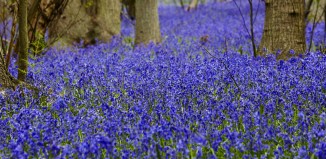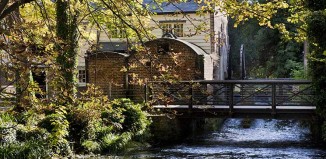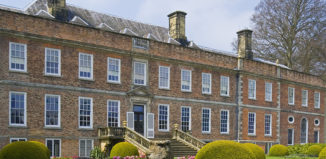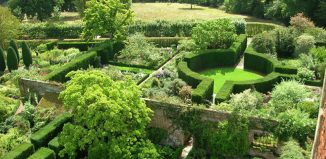Calke Abbey

Make your way through Calke Abbey’s maze-like interior and you will, little by little, be transported into a lost era. Some rooms look so lived-in and are so packed full of ‘stuff’ that you could be forgiven for thinking the owner has just gone out for a walk.
Surprising, at times even mesmerising, Calke Abbey is like a giant and ever-so-slightly dusty cabinet of curiosities, filled with antiques and artefacts, stuffed animals and myriad minerals. This was the home of generations of voracious collectors and relentless hoarders. Objects are piled high onto beds, crammed into cabinets, shoe-horned into no longer functional rooms.
There is no artifice, no judicious arrangement of objects. Calke Abbey is what it is – an evocative and at times poignant reminder of bygone and fading age. It is far more real, and arguably a lot more revealing, than any of its manicured cousins. Paint and wallpaper peel off walls; cracks are visible on ceilings; carpets are – here and there – threadbare.
This is a house which like so many, now sadly lost, aristocratic homes, fell into virtual disrepair during the 20th century, due to reduced revenues from estates and the ravages of two world wars. History was kind to Calke Abbey, though, and it managed to be rescued from imminent ruin.
Opportunity, as it often does, came disguised as misfortune. The last owner, Charles Harpur-Crewe, died in 1981, leaving a tax bill of £8 million to his younger brother Henry. Unable to raise the necessary funds, Henry was nevertheless determined to save his home. He supported a huge fundraising campaign, agreed to be photographed among his cluttered rooms and interviewed on television and in the national press. Eventually the money was found and Calke Abbey was handed to the National Trust in 1985.
Instead of restoring the house to its former glory, the Trust did just the opposite. The idea was somewhat unusual: to present the interiors exactly as it they were when Charles Harpur-Crewe died, warts and all. The building, on the verge of collapse, was made safe and vital repairs were undertaken. The rooms and their contents were checked for woodworm, mildew and beetle damage. Each and every item was catalogued and then put back in its original spot. Walls kept their peeling wallpaper and flaking paint; ceilings were not re-plastered and still today flaunt large cracks.
This apparently laissez-faire approach is not without its challenges. John Parkinson, house manager at Calke Abbey explains: “Trying to preserve it as it was found becomes harder as time passes. Every conservation decision has to bear in mind the special qualities that we try to hold onto. A lot of work goes on that is ‘invisible’ to the casual observer. We do wonder how long we can preserve things the way we do. Some types of object, for example textiles, are inherently weak and need considerable conservation work. Gradually Calke is coming to represent the decline which happened to so many country estates in the 20th century, rather than specifically Calke as found.”
A challenge it might be, but visitors appreciate the effort and the atmosphere of quiet decay that pervades the house. In a place full of treasures so densely packed together, few individual items stand out. The rooms themselves are the stars of the show and the journey, full of unexpected twists and turns, is quite something too.
Strangely, there was never an abbey here; the term was added to Calke’s name in the early 19th century to give the house more cachet – not that it needed it. But a priory there was, which was active between the 12th century and Henry VIII’s Dissolution of the Monasteries in the mid-16th century. The classically proportioned building you see today, constructed of warm Derbyshire stone, dates from 1701–3. Although the architect is unknown, its style is fairly typical of the time and may have been inspired by the work of the sixteenth-century French Renaissance architect Philibert de L’Orme.
One of the first interiors you’ll encounter is the quirky Caricature Room. Its walls are cloaked in late 1790s and 1800s satirical cartoons by some of the very best caricaturists of the time, including Gillray and Cruikshank. Conservation has revealed that in places the prints are up to three layers deep, suggesting a regular updating of the decor with fresh cartoons.
Further on is the Butler’s Pantry, an altogether more functional space. The fluorescent lighting, sink and general decoration all date from the 1960s, when electricity and telephones were finally introduced at Calke. Even after electricity was made available, visitors were still shown round the house by candle light – and their arrival by motor car was positively frowned upon. In his later years, Charles Harpur-Crewe used this room as an occasional kitchen, the main kitchen having been deserted in the 1920s due to lack of staff.
In the small Breakfast Room, you get your first glimpse of Calke’s delicate state of decay. The original mellow green colour scheme adds to the room’s intimate feel, while the paintings, thanks to their lack of restoration, radiate a peaceful ‘golden’ light. Having not undergone the usual cleaning away of yellow varnish, the pictures are exactly as Charles would have seen them.
Nothing can prepare you for the visual assault that is the Saloon. Rows of deer heads and family portraits stare at you from above, while cases packed with collections of archaeology, mineralogy and natural history draw your gaze downwards. Originally the house’s Great Hall, through which guests would enter the house, this space was turned into the Saloon in the early 19th century, when Sir John Harpur Crewe transformed it into his private museum. Upstairs the Bird Lobby features yet more stuffed birds, which, according to journalist and historian Simon Jenkins, is ‘astonishing for the sheer weight of taxidermy’. This could equally well be said of the Oak Bedroom, also filled to the brim with cases of stuffed birds, although here they are haphazardly arranged, being in store, rather than on display.
Clutter at Calke comes in many guises. Some rooms were latterly used as storage, such as the Oak Bedroom and Sir Vauncey Harpur Crewe’s bedroom, where items are left scattered on his bed. Others are more decorative, such as the ostentatious Drawing Room, lavish with ornate furniture and decorative items and dripping in gilding.
Contrasting spaces and atmospheres produce a thrilling sense of discovery. Small spaces counter larger ones. Light, displayed in the Bird Lobby, gives way to darkness, best seen in the delicate and tiny Gardner Wilkinson Library. Flamboyance follows plainness. Take, for instance, the West Passage. Here is one of the least altered and simplest parts of the house; its yellow and white lime-washed walls representative of basic decorative schemes in domestic quarters of Victorian country houses. Yet just beyond sits Calke’s pièce de résistance: a magnificent and perfectly preserved State Bed. This Baroque bed, probably made for George I in about 1715, was never actually used, perhaps because none of the rooms in the house, apart from the Saloon, were high enough to accommodate it. So the bed hangings were packed away in a box, only to be discovered 270 years later. Today they are as vibrant as the day they were made, which cannot be said for the rest of this endlessly fascinating house.
Calke Abbey, Ticknall, Derby, DE73 7LW
Tel: 01332 863 822







